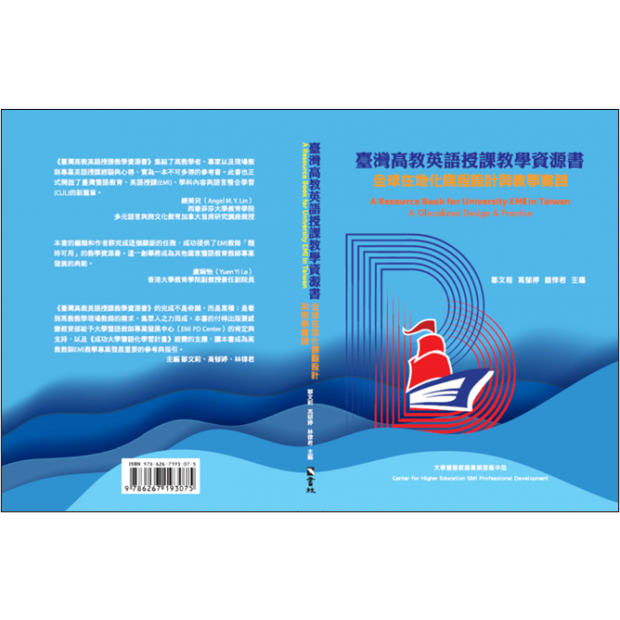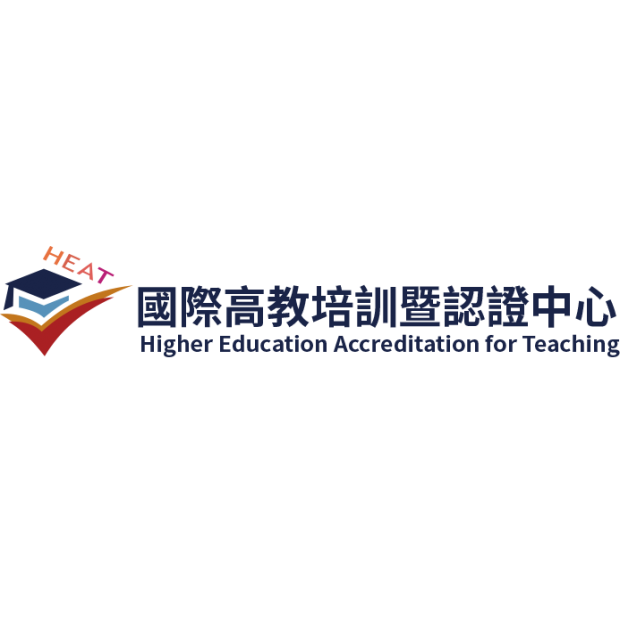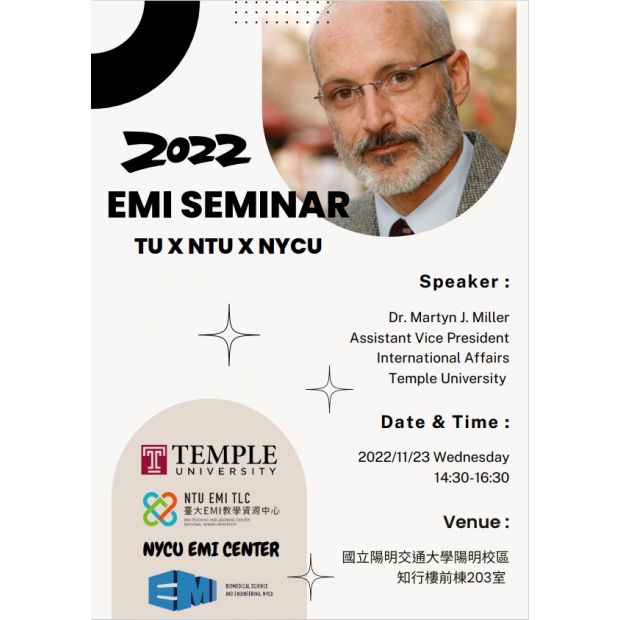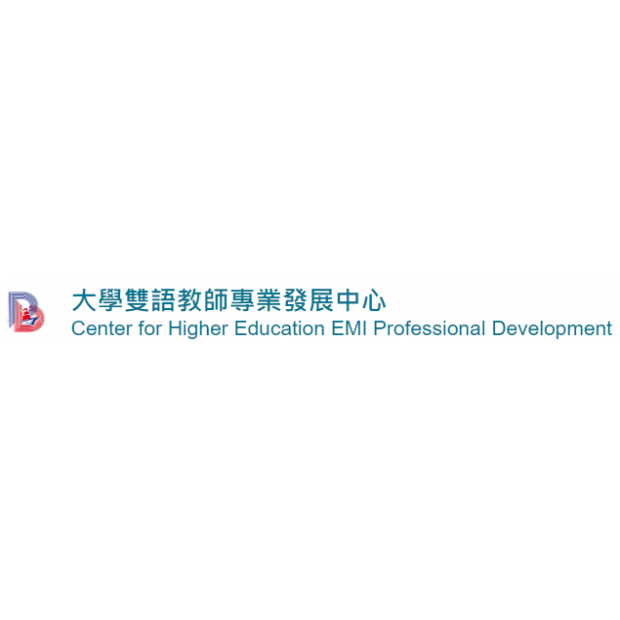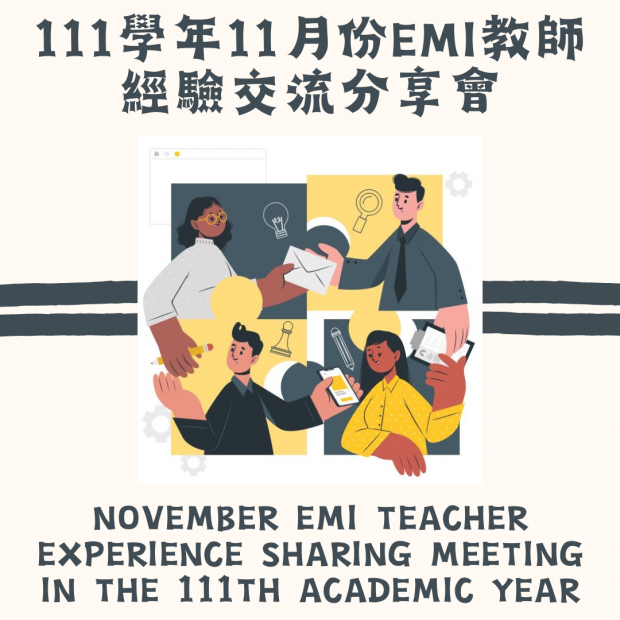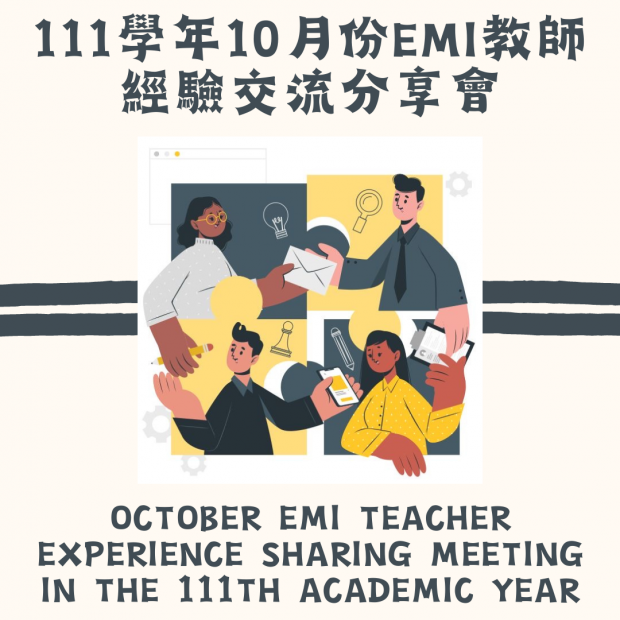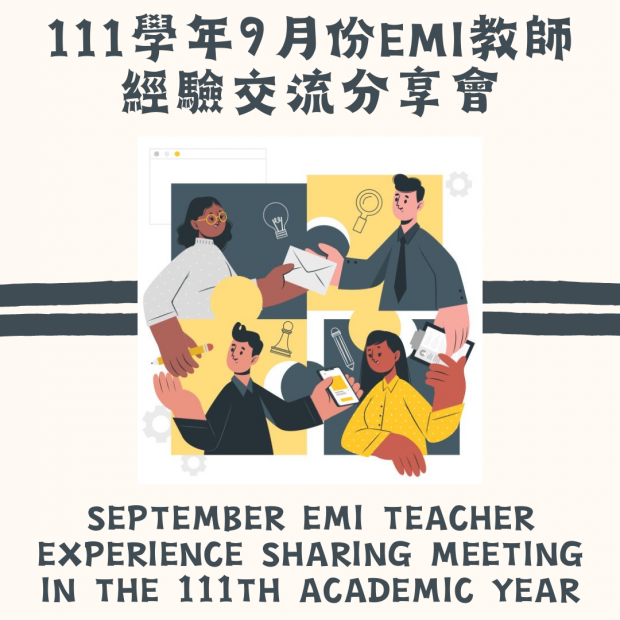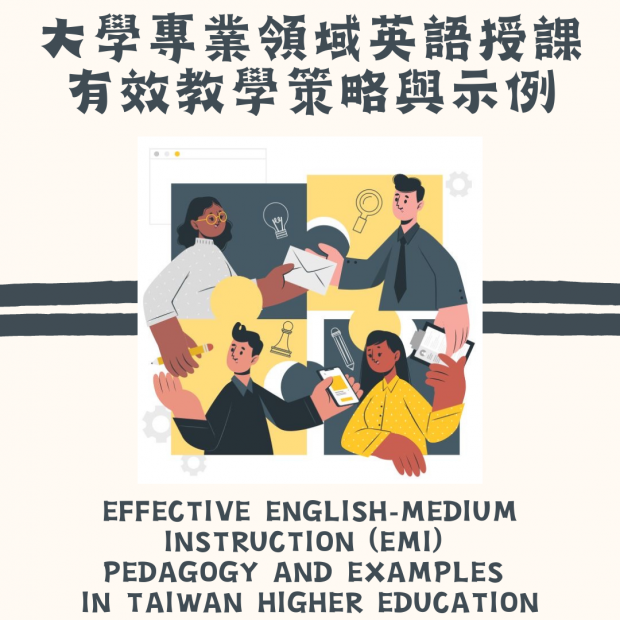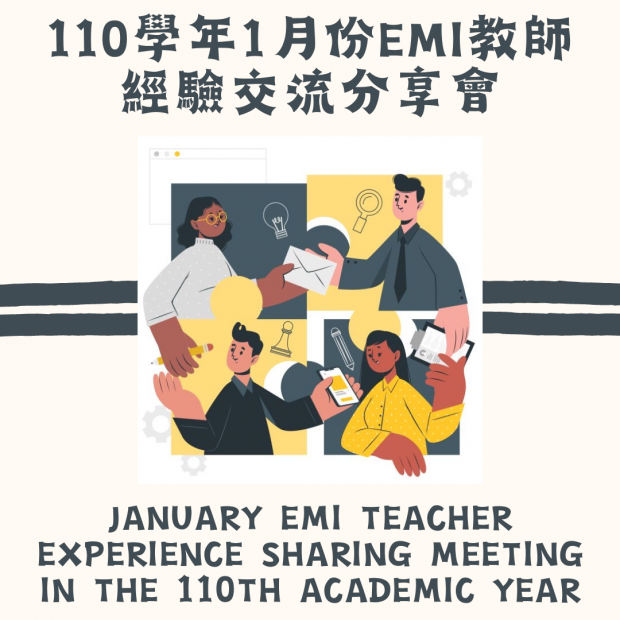EMI教師增能與交流專區 EMI Teacher Empowerment & Workshop
-
Read More
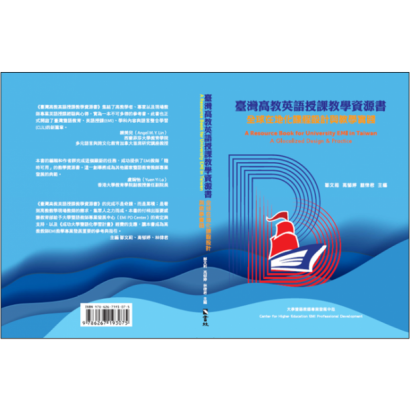 臺灣高教英語授課教學資源書-- 全球在地化課程設計與教學實踐 A Resource Book for University EMI in Taiwan: A Glocalized Design & Practice
臺灣高教英語授課教學資源書-- 全球在地化課程設計與教學實踐 A Resource Book for University EMI in Taiwan: A Glocalized Design & Practice臺灣高教英語授課教學資源書-- 全球在地化課程設計與教學實踐 A Resource Book for University EMI in Taiwan: A Glocalized Design & Practice
臺灣高教英語授課教學資源書-- 全球在地化課程設計與教學實踐
A Resource Book for University EMI in Taiwan: A Glocalized Design & Practice -
Read More
 國際高教培訓暨認證中心 Higher Education Accreditation for Teaching
國際高教培訓暨認證中心 Higher Education Accreditation for Teaching國際高教培訓暨認證中心 Higher Education Accreditation for Teaching
-
Read More2023 Jan 11 Seminar in Medical Field NYCU x CMU
2023 Jan 11 Seminar in Medical Field NYCU x CMU
第一部分-兩校對雙語教學交流
中國醫大
願景
優良的教師雙語教學知能
學生良好之雙語溝通與思維能力
雙語友善之醫學院
雙語中心架構
校長室
教務處
雙語教學推動資源中心
課程規劃組
師資培育組
學習評量組
EMI執行項目
教師端
定期培訓(增能工作坊)
不定期培訓(邀請校外講者)
EMI種子教學培訓
精進英語授課技巧教師專業社群
劍橋EMI全英語專業進修線上課程
觀課制度
遴選EMI教學優良教師
研擬成效評估機制
學生端
國際文化週
海外留學職涯分享
English Corner
全英語金頭腦科研簡報比賽
全英語服務學習志工經驗分享
TOEIC校園考
EMI課程學習心得影片競賽
活動花絮
未來願景
持續推動醫學科學研究,以對國家產業、社會發展繼續提出重要貢獻為目標,讓中國醫藥大學醫學院師生,具備跨領域新合作力和跨國研究領導力,成為後疫情時代之重要生醫研究人才。
陽明交大
雙語推動組織架構
副校長室
教務處
國際高教認證培育中心
教師發展中心
雙語學習辦公室OBE
語言學習與寫作中心
EMI課程教學與學習中心
英語授課與學習中心
國際處
重點培育學院
生醫工程學院-雙語計畫推動工作小組
資訊學院
現況分析
課程教學模式限制
就業環境轉變
英語應用侷限於教室
英語課程推廣挑戰
學生英語程度與學習能力差異
雙語目標與四大核心價值
在地人才國際化,國際人才在地化(Glocalization)
Domain Knowledge
Effective Communication
Critical Thinking
Global Perspective
三面向推行策略
學生端(動機與主動性)
Pre-EMI Workshop
Supporting 團隊-EMI課程學生手冊
LLWC English Workshops
學生英語自主活動
學生問卷調查
教師端(開課與增能)
EMI開課與修讀情況
教師經驗交流工作坊
教師問卷調查
生醫工程學院EMI教師教學獎
教師EMI授課獎勵金
增能/培訓工作坊
跨校交流會
高教資源書
校園端(支持與連結)
校園生活Podcast
院友訪談
Free Lunch Free Talk(連結國際理解文化特性)
If you can have both hands to EMPOWER yourself, why not?
慣用手:Mother Language
非慣用手:Second Language
第二部分-圓桌會議
議題一:如何增加生醫領域師生進行EMI教學/修課之動機?
議題二:臨床工作是否完全不需使用英文?
議題三:如何幫助學生更有效於EMI課程中學習專業知識?
議題四:哪些活動安排策略與支持系統能夠發揮最大影響力?
議題五:其他建議之執行指標亮點與重要目標?
-
Read More
 TU X NTU X NYCU EMI SEMINAR
TU X NTU X NYCU EMI SEMINARTU X NTU X NYCU EMI SEMINAR
TM x NTU x NYCU EMI SEMINAR
歡迎天普大學副校長MARTYN JOHN MILLER、臺大雙語教育中心與臺大EMI教學資源中心來訪陽明交通大學,進行EMI學術研討會
Time:
Nov 23, 2022(Wed.) 14:30-17:30
Venue:
Zhi Xing Building (front) room 203
Sharing:
Temple experience
Why bilingual education?
Divergent thinking, memory, reasoning, and problem-solving abilities
Awareness and appreciation of different cultures
Flexibility, adaptability, and openness in attitude
Globalization: language learning is central to politics, economics, history, and education
Concerns
Can we really trust current English proficiency tests (TOEFL, CEFR, IELTS, etc.)?
They could be biased.
Students with high test scores can’t really deliver their professional knowledge in English.
Is money the best motivation?
It won’t be sustainable.
International personnel costs more than local personnel
Does the government have a commitment to them?
Is CEFR B2 level enough for students to take EMI courses?
B2 is only daily conversation; C1 is more suitable for most academic studies, because C1 students
Speak English fluently and spontaneously
Do not see English as intimidating
Why don’t we start preparing students for B2 level at high school, and help them reach C1 level in the first year of university?
Temple’s strategies
For faculty development
Improve faculty on English proficiency and pedagogy: extended pedagogy workshops
1 to 2 days, for more than 2 hours/each, conducted in English
Not just teach English, but also pedagogy
Peer teaching with foreign faculty member
Classroom observation through objective, non-threatening methods
When an outsider walks in the classroom, it really scares both the students and the teacher.
Provide resources on teaching international students
Making teaching award winners mentors
For students’ language proficiency
2 day intensive orientation
Student leadership: encourage students to lead something
International Student Advisory Board
Temple Student Government
Student Worker Positions
International students’ working opportunity
Student Success Center
(Low stress/ must speak English)
Language Tutor
Writing and Research Retreats
Academic coaching
Conversation hours
International coffee hours (the problems they’re facing in their countries right now)
Open discussion
Question: Although at least 60% of students in NYCU reach CEFR B1 level, students’ English proficiency is still one big challenge in EMI courses. Any good strategy for this?
In their freshman year, spend more time/ put more English language courses in the curriculum to enhance their English proficiency.
Peer teaching: students learn more from their classmates
What Temple did: intensive 4-week language training before the semester begins for those with lower English proficiency
It’s conditional.
Statistics have shown that it’s enough to help them go through EMI courses
Ideally no more than 15 students/per class; maximum 18 students; with 1 instructor
Question: How can we find an EMI teacher’s true passion or motivation?
Select high motivated EMI teachers
Question: How do we encourage students? How can we use all these resources to maximize the impact?
Many medical students think that they’ll eventually be serving local people, so they don’t care about being bilingual or not.
They’ll need to speak not only Mandarin, but also dialects, Hakka, etc. There stands the importance of picking up another language.
To maximize the impact of all the resources, think about collaboration.
Lots of students from NYCU Hsinchu campus (most with engineering background) want to work abroad/in an international company, which serves as a good incentive
Students care about their professional development outcomes, so tell them how much money they can make by adding a language
Suggestion: immerse students more in the bilingual environment
Open EMI classes consistently (every semester)
Use english to study
Question: In Taiwan, the students are not ready to become bilingual yet, but the government is pushing. Has Dr. Miller observed any similar situation in other universities?
Dr. Miller: I don’t really have this kind of experience. But, Canada is the model. It’s been only 20~30 years for them to come this far, becoming bilingual. We need to learn from them.
Different motivation
Canada (supporting environment)
Has a national definition of “bilingual”
Government employees need to pass French tests
Collected resources
Taiwan (top-down policy)
Money from government is not stable/ sustainable
“You can give me lots of money but you can’t buy Chinese out of me.”
Do people really need English in Taiwan?
Suggestion: The nation needs to embrace this policy as a whole, and to accept English as a second language. Until then, promoting EMI courses won’t be easy.
Suggestion: to create EMI teaching awards
For teachers who really generate impact to the society
Sharing: challenges in NTU
Although student’s English proficiencies are better, NTU still works on improving it
全英培力課程: teach about the foundation of language
Activities to create bilingual environment: English corners, workshops, etc
3MT competition
Authorized by University of Queensland
Participants are coached 1 by 1
The winner goes to Australia for further competition
These activities are actually quite popular: about 4,000 students participated
NTU doesn’t intend to separate students from faculties. These activities are for both the students and the faculty
Real challenge: finding those students who have the potential/ they don't have the opportunity to show their potential
Question: Speaking of motivated/ not-motivated/ likely to be motivated students, what kind of students should we focus on in the long run?
Ans: students who are likely to be motivated
We aim for the potential, see it as an investment.
Suggestion: when the problem goes back to the policy maker
The KPI of current policy is not realistic. 10 years is not enough to achieve it.
Communicate or negotiate with the government side/ speak up to MOE
Education is an economic engine. Show them how the BEST program will bring in money.
The USA has realized that education is a business. Economic impact indicators are made to prove that point. It took almost 20 years for the USA to bring industry in, then the money will speak up. (Reference: 2022 Economic Report of the United States) -
Read More
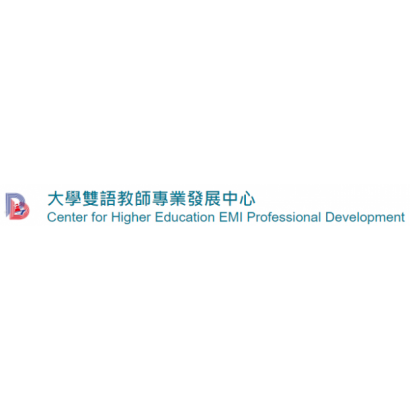 大學雙語教師專業發展中心 Center for Higher Education EMI Professional Development
大學雙語教師專業發展中心 Center for Higher Education EMI Professional Development大學雙語教師專業發展中心 Center for Higher Education EMI Professional Development
參訪大學雙語教師專業發展中心
Center for Higher Education EMI Professional Development -
Read More
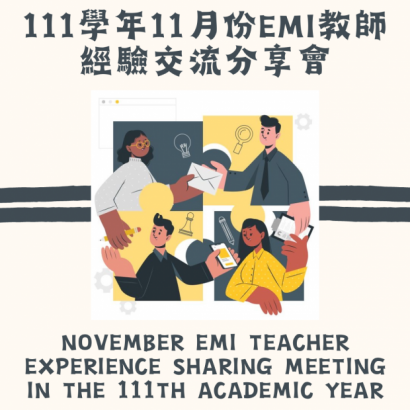 [2022.11.10] 111學年11月份EMI教師經驗交流會 November EMI Teacher Experience Sharing Meeting in the 111th Academic Year
[2022.11.10] 111學年11月份EMI教師經驗交流會 November EMI Teacher Experience Sharing Meeting in the 111th Academic Year[2022.11.10] 111學年11月份EMI教師經驗交流會 November EMI Teacher Experience Sharing Meeting in the 111th Academic Year
111學年11月份EMI教師經驗交流分享會
分享教師:醫學生物技術暨檢驗學系 張懿欣老師
時間:2022年11月10日 12:10-13:10
地點:知行樓前棟 203教室
與會者:陳喬男老師、張景智老師、莊惠燕老師、盧家鋒老師、嚴偉哲老師、高瑀絜老師、蔡明翰老師、薛特老師、葉祖秀、陳奕潔
經驗分享內容:
英語授課
初衷/動機與轉變
從歐洲的Summer school開始,2學分/36個小時,來自18個不同國家的學生,開啟了英語授課之旅。2011年在陽明大學的國際衛生學程中,受邀開始在學程中擔任課程的老師,更是讓我有了不同的教育眼光。
英語授課的想法
11年下來,對於英語授課其實每年的經驗都不盡相同,到了2022年,從這學期開始教授了EMI課程,其實會發現,EMI授課與英語授課真的完全不同,因為面對到的學生特質,真的完全不同
外籍vs臺灣學生
心理準備
外籍的學生有幾個特質,學習動機強、主動性/互動性強,雖然在國際學程當中,英語能力差異不大,但腔調的差異,有時候在溝通上還是會發生讓人印象深刻的事情。最後是專業背景的歧異,在這方面,可以透過了解學生背景、日常生活的對話聊天,據以決定課程設計與內容,讓知識可以更加深入在學生腦海中。
臺灣的學生不像外籍學生一樣,學習動機普遍較低,更不用提互動性,如何讓臺灣學生提高這些動機,我想這是老師們在設計課程上需要更加費心之處。
授課心得與建議
對於專業背景的歧異,了解並尊重學生背景,透過跟學生的聊天,調整上課的形式,加入一些online teaching tool。
EMI以單次課程為單位,建議在授課第一堂說明授課大綱,在課程中對於專有名詞的定義的解釋,可以由中文來輔助。
增加Q&A的時間,最後,將整堂課做結語,讓學生可以有更多的印象。
結語
在政策面/執行面上,必修/證照專業科目要翻轉成EMI授課還是有許多壓力,因為是證照考試的系所,因此系上是從選修開始翻轉。對於學生,會希望以鼓勵性取代強制性,讓學生有夠多學習動機,進而增加學習表現。對於教師端,會建議鼓勵的配套措施(如教師評鑑)。最終回到教育本質上,百年樹人/素質養成really takes times!
November EMI Teacher Experience Sharing Workshop of the 111th Academic Year
Speaker: Teacher Zhang Yixin from the Department of Biomedical Engineering and Biotechnology
Date: November 10, 2022
Time: 12:10-13:10
Location: Room 203, Front Building of Zhixing Building
Participants: Teacher Chen Qiaonan, Teacher Zhang Jingzhi, Teacher Zhuang Huiyan, Teacher Lu Jiafeng, Teacher Yan Weizhe, Teacher Gao Yujie, Teacher Cai Minghan, Teacher Xue Te, Ye Zuxiu, Chen Yijie
Experience sharing content:
English Teaching
Original Intention/Motivation and Changes
Starting from the European Summer School, with 2 credits/36 hours, and students from 18 different countries, it opened the journey of English teaching. In 2011, I was invited to teach courses in the International Health Program at Yang Ming University, which gave me a different perspective on education.
Ideas about English Teaching
Over the past 11 years, the experience of English teaching has been different every year. In 2022, starting from this semester, teaching EMI courses, I discovered that EMI teaching is really different from English teaching because of the characteristics of the students we face, which are completely different.
Foreign vs Taiwanese Students
Mental Preparation
Foreign students have several characteristics: strong motivation to learn, strong initiative/interactivity. Although there is not much difference in English proficiency in international programs, differences in accents sometimes lead to memorable incidents in communication. Finally, there is the diversity in professional backgrounds. In this aspect, by understanding students' backgrounds and having conversations about their daily lives, we can determine course design and content to deepen knowledge in students' minds.
Taiwanese students are not like foreign students. Their motivation to learn is generally lower, not to mention interactivity. How to motivate Taiwanese students to improve in these areas is something that teachers need to put more effort into in course design.
Teaching Experience and Suggestions
Regarding the diversity in professional backgrounds, it is important to understand and respect students' backgrounds and adjust the format of classes through conversations with students, incorporating online teaching tools.
For EMI courses, which are taught on a per-session basis, it is recommended to explain the course outline in the first class and provide definitions of specialized terms with the assistance of Chinese.
Increase the time for Q&A. Finally, conclude the entire class to leave a stronger impression on students.
Conclusion
In terms of policy/implementation, there is still a lot of pressure to transform compulsory/licensed professional subjects into EMI courses because it is a department related to licensing exams. Therefore, the transformation starts from elective courses. For students, it is hoped to replace compulsion with encouragement, providing them with sufficient motivation for learning and thereby improving learning performance. For teachers, it is recommended to have supportive measures such as teacher evaluations. Ultimately, it returns to the essence of education, "Educating students for a century/developing their qualities" really takes time! -
Read More
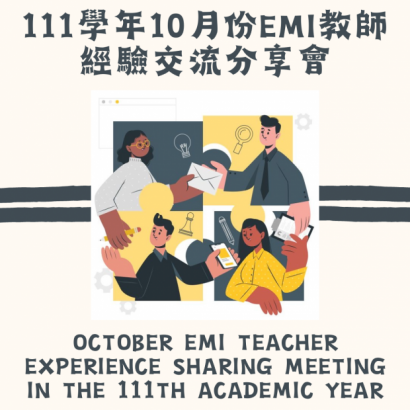 [2022.10.19] 111學年10月份EMI教師經驗交流會 October EMI Teacher Experience Sharing Meeting in the 111th Academic Year
[2022.10.19] 111學年10月份EMI教師經驗交流會 October EMI Teacher Experience Sharing Meeting in the 111th Academic Year[2022.10.19] 111學年10月份EMI教師經驗交流會 October EMI Teacher Experience Sharing Meeting in the 111th Academic Year
111學年10月份EMI教師經驗交流分享會
分享教師:物理治療暨輔助科技學系 陳喬男老師
時間:2022年10月19日 12:10-13:10
地點:知行樓前棟 203教室
經驗分享內容:
1.學生回饋
透過表單填寫,發現其實有學生回饋對於EMI授課是一種跳脫舒適圈的一種方式。在量化中的表單中得到學生認為EMI授課可以提升英語能力、有助於提升畢業後就業的競爭力、比以前更專注在課堂中、對於知識上的理解並沒有感到太困難等。
學生給予的回饋包含專有名詞需要中文解釋、小組討論是非常好的學習方式、透過Kahoot可以知道課程重點是什麼,其實可以知道學生並沒有想像中的這麼排斥。
2.雙語教學老師壓力大,怎麼辦?
雙語教學對老師而言,也是一種挑戰,無論是自信、語言、建立學生對我們的信任上。
以身作則,建立一個友善支持的教室環境,讓學生知道語言是溝通的工具,別害怕,說就對了。
做一個身教,讓學生知道,老師也會有遭遇挑戰的時候,我們也會怕、也感到壓力,但我們嘗試且盡力做。也希望學生給予真實回饋,唯有這樣,才有師生雙贏的局面。
3.物輔系大二必修課-老人學與成功老化
小組討論並請代表發言
學生的英語能力其實很好
外籍生修課有助雙語教學
除了上課,還有Kahoot問答
4.結論
雙語教學增加學生以英文溝通的習慣與勇氣,強化國家未來主人翁與國際互動的能力。
身為學校教師,教育下一代使他們更好是我們的責任,因此試著嘗試,並在過程中積極檢討與調整,確保學生的學習不打折扣,且獲得雙語教學可能帶來的好處。
October EMI Teacher Experience Sharing Meeting in the 111th Academic Year
Speaker: Mr. Chen Qiaonan from the Department of Physical Therapy and Assistive Technology
Date: October 19, 2022
Time: 12:10-13:10
Location: Classroom 203, Front Building of the Zhixing Building
Experience Sharing Content:
Student Feedback
Through form submissions, it was found that EMI teaching is perceived by students as a way to step out of their comfort zone. Quantitative data from the forms showed that students believed EMI teaching can improve their English proficiency, enhance their competitiveness in future employment, increase their focus in the classroom, and not find the understanding of subject matter overly challenging.
Student feedback included the request for Chinese explanations of specialized terminology, recognition of the effectiveness of group discussions as a learning method, and acceptance of tools like Kahoot to understand key points of the course. Students did not exhibit the anticipated resistance towards EMI teaching.
Bilingual teaching can place a significant amount of stress on teachers. What can be done to address it?
Coping with the Challenges of Bilingual Instruction Bilingual instruction poses challenges for teachers, including self-confidence, language proficiency, and building trust with students.
Leading by example, creating a friendly and supportive classroom environment, and reassuring students that language is a tool for communication can help overcome these challenges.
Being a role model, letting students know that teachers also face challenges, fears, and pressure, but are willing to try and do their best. Encouraging students to provide honest feedback can create a win-win situation for both teachers and students.
Required Course for Sophomores in the Department of Physical Therapy and Assistive Technology: "Gerontology and Successful Aging"
Group discussions and representative presentations.
Students demonstrate good English proficiency.
The presence of international students in the class contributes to bilingual instruction.
In addition to regular class activities, the use of Kahoot for interactive quizzes is beneficial.
Conclusion
Bilingual instruction enhances students' habits and courage in communicating in English and strengthens their ability to interact internationally as future leaders of the country.
As educators, it is our responsibility to educate the next generation and strive to ensure that their learning experiences are not compromised. We actively review and adjust our teaching methods to maximize the benefits that bilingual instruction can bring to students. -
Read More
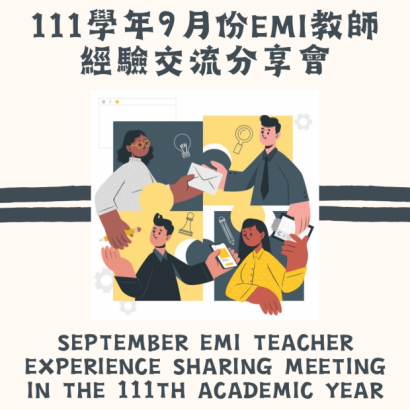 [2022.09.29] 111學年9月份EMI教師經驗交流會 September EMI Teacher Experience Sharing Meeting in the 111th Academic Year
[2022.09.29] 111學年9月份EMI教師經驗交流會 September EMI Teacher Experience Sharing Meeting in the 111th Academic Year[2022.09.29] 111學年9月份EMI教師經驗交流會 September EMI Teacher Experience Sharing Meeting in the 111th Academic Year
111學年9月份EMI教師經驗交流分享會
分享教師:生物醫學影像暨放射科學系 高瑀絜老師
時間:2022年09月29日 12:10-13:10
地點:知行樓前棟 203教室
經驗分享內容:
Our Students are Good Enough: They can do more than what we expected
透過課堂中的學生表單回饋,會發現學生們並沒有如教師們所想像地這麼排斥EMI課程,甚至學生反饋EMI這套教學模式可以保留給學弟妹。在準備EMI的過程中,教師不再只有傳統教學的實體授課,非同步的線上課程也是新時代的授課模式,並得到了許多學生的支持與喜歡。
談論到EMI授課,學生當然還是會覺得中文授課較好,但課程難易度是否因為語言的關係而導致困難的高牆攀升許多?其實透過學生的反饋是一目瞭然,困難會有所提升沒錯,但也不至於讓學生感到非常挫敗的程度,因此老師在翻轉EMI的動力還是有的。
Course Design is the Key: Not English but Couse Design Matters
EMI Video Clips
將線上課程內容分成每段影片15-20分鐘,讓學生更簡單讀取並註記影片進度。
Blended Learning: Student support and motivation
利用平板,將授課內容錄製下來,並運用網路幫助學生接收新知、練習、與同學討論。
課堂內則注重運用新知解決問題,幫學生整理、歸納出屬於他們自己的知識。
成功的Blended Learning在於學生能自主學習,不全靠教師的講授來取得新知。
Blended Learning: Padlet
透過Padlet,讓學生分組將課堂作業呈現出來,並之後也能輸出成PDF檔,成為學生的學習紀錄。
Review Quiz: Kahoot
用簡單的互動平臺,3-5分鐘的問答可以知道學生今日學習情況。
September EMI Teacher Experience Sharing Meeting in the 111th Academic Year
Sharing Teacher: Ms. Gao Yu Jie from the Department of Biomedical Imaging and Radiological Sciences
Date: September 29, 2022
Time: 12:10-13:10
Location: Classroom 203, Front Building of Zhixing Hall
Experience Sharing Content:
Our Students are Good Enough: They can do more than what we expected
Through student feedback forms in the classroom, we have discovered that students are not as resistant to EMI courses as we might have imagined. In fact, students have provided feedback that the EMI teaching model can be continued for future students. In the process of preparing for EMI, teachers are no longer limited to traditional face-to-face teaching. Asynchronous online courses have become a new mode of teaching in the modern era, and they have gained the support and appreciation of many students.
When it comes to EMI teaching, students may still prefer courses taught in Chinese. However, does the difficulty level of the course increase significantly due to the language barrier? The feedback from students is clear: the difficulty does increase to some extent, but it does not make students feel overwhelmingly defeated. Therefore, teachers still have the motivation to embrace EMI.
Course Design is the Key: Not English but Course Design Matters
EMI Video Clips
Divide the content of online courses into 15-20 minute video clips, making it easier for students to access and annotate the progress of the videos.
Blended Learning: Student support and motivation
Use tablets to record the course content and utilize the internet to help students acquire new knowledge, practice, and discuss with classmates. In-class activities focus on applying new knowledge to problem-solving, helping students organize and summarize their own knowledge. The success of Blended Learning lies in students' ability to learn autonomously, not solely relying on teacher lectures to acquire new knowledge.
Blended Learning: Padlet
Through Padlet, students can present their class assignments in groups, and the outputs can be exported as PDF files, serving as students' learning records.
Review Quiz: Kahoot
Using a simple interactive platform, a 3-5 minute quiz can assess students' learning progress for the day. -
Read More
 [2022.07.27] 大學專業領域英語授課有效教學策略與示例 Effective English-Medium Instruction (EMI) Pedagogy and Examples in Taiwan Higher Education
[2022.07.27] 大學專業領域英語授課有效教學策略與示例 Effective English-Medium Instruction (EMI) Pedagogy and Examples in Taiwan Higher Education[2022.07.27] 大學專業領域英語授課有效教學策略與示例 Effective English-Medium Instruction (EMI) Pedagogy and Examples in Taiwan Higher Education
大學專業領域英語授課有效教學策略與示例
一、活動資訊:
(一)主題與講師:
與學生同在一起,EMI數位轉型與混合式學習的華麗變身:成功大學 護理學系 柯乃熒教授
醫學技術領域英語授課之挑戰與策略:陽明交通大學 生物醫學影像暨放射科學系 盧家鋒教授
亂入EMI叢林者的告白:清華大學 電機系/光電工程研究所 楊尚達教授
英語焦慮者如何準備EMI:陽明交通大學 材料科學與工程學系 鄒年棣教授
(二)時間:2022/07/27(三) 10:00~12:00 13:30~15:30
(三)活動方式:實體+線上
Effective English-Medium Instruction (EMI) Pedagogy and Examples in Taiwan Higher Education
Event Information:
(1) Theme and Speakers:
Along With Students: Transforming Teaching through Digital and Blending Learning - Professor Ke Naiying, Department of Nursing, National Cheng Kung University
Challenges and Strategies for EMI Courses in Medical Technology - Professor Lu Jiafeng, Department of Biomedical Imaging and Radiological Sciences, Yang-Ming Chiao Tung University
My EMI Stroy: A Beautiful Accident?! - Professor Yang Shangda, Department of Electrical Engineering/Institute of Photonics, National Tsing Hua University
How to prepare EMI as a nervous English speaker - Professor Zou Niandi, Department of Materials Science and Engineering, Yang-Ming Chiao Tung University
(2) Date: July 27, 2022 (Wednesday)
(3) Time: 10:00 AM - 12:00 PM, 1:30 PM - 3:30 PM
(4) Event Format: In-person + Online -
Read More
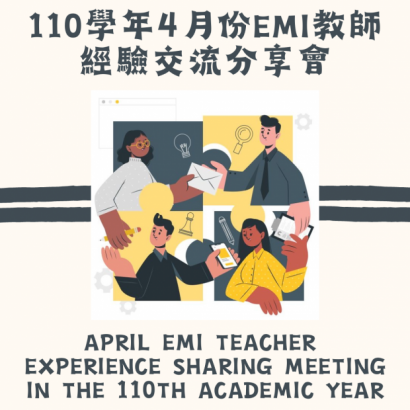 [2022.04.13] 110學年04月份EMI教師經驗交流會 April EMI Teacher Experience Sharing Meeting in the 110th Academic Year
[2022.04.13] 110學年04月份EMI教師經驗交流會 April EMI Teacher Experience Sharing Meeting in the 110th Academic Year[2022.04.13] 110學年04月份EMI教師經驗交流會 April EMI Teacher Experience Sharing Meeting in the 110th Academic Year
110學年04月份EMI教師經驗交流會
分享教師:心智哲學研究所 嚴偉哲教授 & 生物醫學影像暨放射科學系 盧家鋒教授
時間:2022年10月19日 12:10-13:10
地點:知行樓前棟 203教室
經驗分享內容:
心智哲學研究所 嚴偉哲教授
1.Group discussion
•Do you think it’s reasonable for Taiwan to promote English- Medium Instruction (EMI)? If so, why? If not, why not?
•How can we incentivize teachers to teach EMI courses? How can we incentivize students to take EMI courses?
•What are the biggest challenges when it comes to converting a Chinese-Medium Instruction (CMI) course into an EMI course?
•In your courses, do you do anything in addition to lecturing during class time? If so, what else do you do?
2. The long-term goal of EMI in Taiwan / NYCU
CMI courses can attract Chinese-speaking students. But English is the language of international communication. EMI courses can attract English-speaking students from all over the world.
3. Concerns you might have about going from CMI to EMI
My advice:
If you teach an EMI course, don’t spend your class time giving a two-hour lecture in English every week.
Do something else during class time, for example, short lectures followed by small group activities and class discussions.
4.Why not give a two-hour lecture in English?
I don’t usually give two-hour lectures.
I use class time to do things that we can’t do outside of class time.
Small group activities followed by large group discussions can only happen when we’re all together.
What’s the difference between watching/listening to a lecture in class (when we’re all together) vs. on YouTube (by yourself)?
5. What if students need a two-hour lecture?
You could make a video of yourself giving a lecture each week, and ask students to watch it outside of class time.
If there are videos on YouTube that have lectures on the material that you’re teaching, you could ask students to watch those videos.
Another advantage of videos vs. in-class lectures: subtitles
6. What can you do in class besides lecturing for two hours?
7. Harry Brighouse’s two iron laws of college reading
“Law One: The more reading you assign, the less the students will read.”
“Law Two: The more you talk in class, the less the students will read.”
8. Challenges and goals in going from CMI to EMI
Ensuring that the use of English does not result in poor learning outcomes
Making effective use of class meetings and mixing lectures with discussions and activities
Encouraging students to complete the required readings before class and to participate actively in class discussions
Using classroom activities to improve students’ understanding of the material and to encourage discussion
生物醫學影像暨放射科學系 盧家鋒教授
1. 醫工學院背景與挑戰
英文是否真的學以致用?
未來專業發展,英文是否為國際競合力的關鍵要素
2. EMI推動經驗分享
3. 教育部推動EMI定義
EMI課程期其授課內容、師生互動、學習教材、學習成效展現及評估應使用英文。EMI課程也能原則性且有30%使用中文。良好的EMI課程實踐應該以古禮學生以英語「說」及「寫」。
4. 教師EMI課程設計
EMI= English as the Medium of Instruction
5. EMI學生回饋
6. English Chat Hour
7. Using Class Time for the Important Content
Need-to-know information
Nice-to-know information
Don’t-need-to-know information
8. Tips on the EMI teaching and assessment
It does take time! Don’t rush.
Redesign your course step-by-step.
Feedback requires practice. -
Read More
 [2022.01.10] 110學年01月份EMI教師經驗交流會 January EMI Teacher Experience Sharing Meeting in the 110th Academic Year
[2022.01.10] 110學年01月份EMI教師經驗交流會 January EMI Teacher Experience Sharing Meeting in the 110th Academic Year[2022.01.10] 110學年01月份EMI教師經驗交流會 January EMI Teacher Experience Sharing Meeting in the 110th Academic Year
110學年01月份EMI教師經驗交流會
NYCU EMI Program
教育部目標 Overall goal of Ministry of Education:
2024年達到「25-20-20」:
英文能力:25% 的大二學生,在聽說讀寫達到 CEFR B2 以上的流利精熟等級
所修學分:20% 的大二學生與碩一學生,在其當年所修學分中的 20% 以上為全英語課程
2030年達成「50-50-50」:
50% 的大二學生在聽說讀寫達到 CEFR B2 以上的流利精熟程度
至少有 50% 的大二學生與碩一學生其當年學分中的 50% 以上為全英語課程
畢業證書EMI修課認證
NYCU運作架構(如上圖)
EMI雙語教學經驗分享會-生物醫學工程學系 羅俊民老師
EMI at the Yang Ming campus
We don’t teach English, we teach in English
We kill two birds (content and language) with one stone if EMI works well.
The major EMI challenge at the YM campus
Teacher lack a consensus on the necessity of teaching in English
Most of them think they have insufficient English proficiency and cannot teach in English fluently, so they have low motivation and lack self-confidence
語言技巧教學之課室用語For English teacher/課室英語手冊For all subject teachers
https://www.emi.eng.ntnu.edu.tw/blank-3
My personal experience at USF
Make your speaking easy to understand and follow
Make sure that students understand essential information
Code-switching should be allowed as a teaching strategy in EMI classrooms when necessary
Help students (less proficient in English) cope with EMI content by facilitating learning in Chinese and guiding them to repackage content
Some closing thoughts
Learning to teach content in English is challenging but worthwhile
Make it easier by
Avoiding reinventing the wheel – many resources are already available
Trying one thing at a time – perhaps start with the most comfortable thing to change
Watching and getting feedback from instructors who are experienced with EMI learning
Being transparent with students
I’m not telling you it’s going to be easy, I’m telling you it’s going to be worth it.

